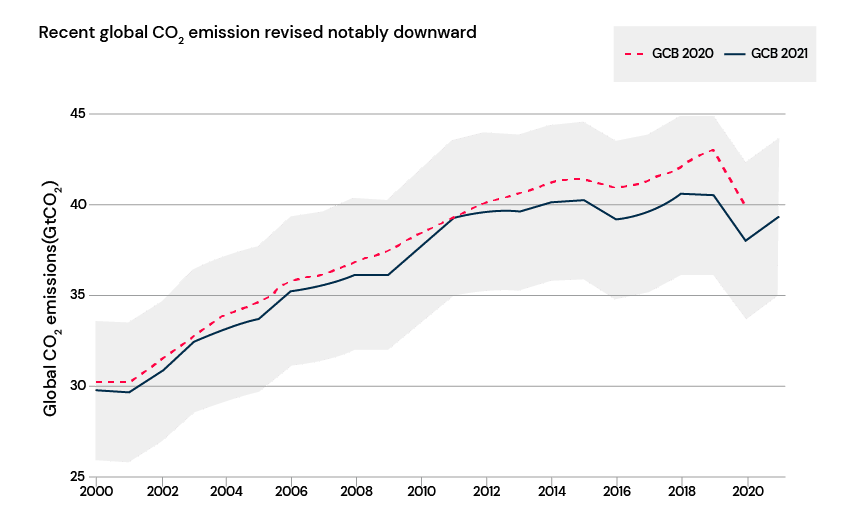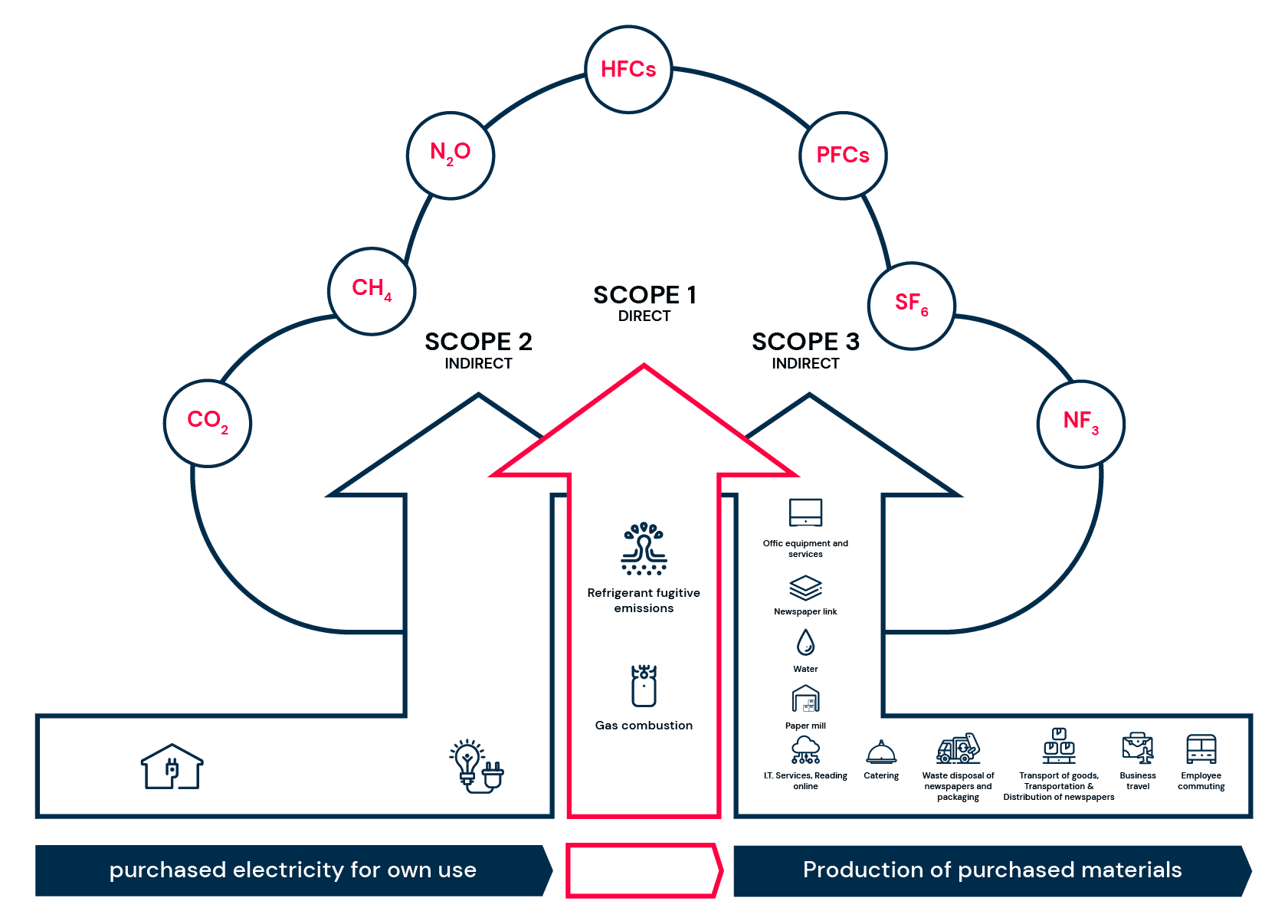IPCC’s Sixth Assessment Report confirmed that global temperatures may rise beyond 1.5˚C, unless there is a serious, collective intent to reduce GHG emissions. Nations and organizations are being called upon to adapt sustainable practices that can positively impact the environment. Carbon accounting in this context will be crucial.
What you did not know about carbon accounting
IPCC’s Sixth Assessment Report confirmed that global temperatures may rise beyond 1.5˚C, unless there is a serious, collective intent to reduce GHG emissions. Nations and organizations are being called upon to adapt sustainable practices that can positively impact the environment. Carbon accounting in this context will be crucial.

1. What is carbon accounting?
Carbon accounting helps organizations measure their greenhouse gas emissions, which enables them to meet emission goals and gain a better understanding of their impact on the environment. It requires companies to set goals within a framework of three scopes:
- Scope 1: Emissions from activities like fuel combustion in factories.
- Scope 2: Emissions from purchased energy for heating, cooling, electricity.
- Scope 3: Emissions from operations like purchasing goods or transportation. As per GHG Protocol, much of corporate emissions flow from Scope 3 sources, making it a key area of focus for carbon accounting.

2. Why is carbon accounting important?
Beyond estimating emissions, carbon accounting or GHG accounting offers several business benefits –
Cost-saving
Just by measuring their environmental performance, enterprises stand to improve on cost savings. It helps minimize investors’ scrutiny and bring in more resilient investments. Oakdene Hollins for Defra’s research states that the UK saved £18bn on water reduction, £4bn on energy use, and £1bn on water use by just measuring its usage.
Talent recruitment and retention
According to Fast Company, millennials are more sustainable conscious with:
- 40% willing to take a significant pay cut to work for an environmentally responsible company
- 70% wish to work at a company with a robust environmental agenda
- 30% noted that they left a job due to the company’s lack of a sustainability plan
- Companies with a robust environmental agenda help attract and retain talent and ensure employees are motivated to be around for the long haul.
Meeting regulatory compliance
Organizations must follow environmental regulations imposed by governments or face penalties in the form of exorbitant fines or negative publicity. Businesses committed to maintaining transparency in their operations and demonstrating it through necessary carbon or GHG reporting have a better chance of gaining faster approvals and certifications that enable faster growth.
Enabling business growth
Professional services firm WYG reported that marketing and sales opportunities motivate enterprises to enhance their carbon accounting. This is because enterprises create market differentiation that helps attract more customers. Even investors demanding detailed environmental information in annual reports are inclined to those companies with detailed carbon accounting reports.
3. What are the corporate carbon accounting challenges?
Enterprises are focusing more on carbon accounting in response to climate change and global warming. This shift is driven by worldwide demand and value creation consideration. However, businesses face roadblocks along the way. We have curated some of the common challenges faced by corporates.
Inconsistent data
Data enables organizations to understand their emissions and curb them, provided there is uniformity in it. This data sits in multiple sources such as processed emissions, purchased electricity and more. Gathering this emission data manually is not only cumbersome, but error prone and lacks standardization. Without a sophisticated reporting solution, companies will not be able to extract, standardize and present the data.
Complicated regulatory frameworks
Reporting standards help increase decision-usefulness of reports. That said, sustainability reporting frameworks are complex given the unique purpose and multiple frameworks that appear confusing and conflicting. Compounding the challenge are varying metrics, definitions, and priorities.
Inaccurate reporting and analysis
Most companies are fairly accurate about emissions they directly produce (Scope 1 of carbon accounting), but accuracy reduces when they account for emissions from supply chain or sold goods (Scope 3 of carbon accounting). This means most carbon reporting goes wrong due to a long list of assumptions. The Weather Channel suggests in the USA, with strong regulations on emission reporting, oil and gas companies tend to underreport their methane emissions. This compounds the issue as we get a false picture of their carbon impact.
4. How can corporate carbon accounting challenges be addressed?
Carbon offsetting
Carbon accounting helps businesses understand their impact on the environment and make informed decisions to reduce it. Enterprises can identify ways to either limit their carbon emissions or offset it with a clearer picture. Carbon offset schemes let organizations invest in critical environmental projects worldwide. This allows companies to balance their carbon footprints.
ESG benchmarking, ratings & risk score
ESG benchmarking helps companies compare their ESG performance against their competitors within an industry. It helps gather crucial insights and improve plans to accomplish net-zero status. ESG ratings help a company measure its exposure to long-term environmental, social, and governance risks that pose a financial risk. The ESG Risk Ratings are categorized across five risk levels: negligible (0-10), low (10-20), medium (20-30), high (30-40), and severe (40+). Together, they reinforce climate change commitments while adhering to industry standards.
Better reporting
To achieve carbon neutral goals, companies must identify relevant frameworks and adhere to them. Two approaches that facilitate businesses to understand their carbon emissions are:
-
Production-based accounting
Check flows of greenhouse gases such as carbon dioxide (CO2) and methane (CH4) in specific areas.
-
Consumption-based accounting
Helps assign carbon flows associated with various products or services like electricity, timber, to where people are using these products.
Besides frameworks, businesses need to focus on getting the right reporting solution that helps them represent data accurately and implement faster decisions.
To help enterprises achieve their goal towards carbon neutrality, Eka offers businesses a comprehensive cloud-driven ESG and Sustainability Reporting solution which works with pre-built frameworks like GRI, CDP, SASB, IR, SERC, SDG, BRSR, and others. Our solution will also help you increase your efficiency to achieve your net-zero goals. Visit our solution page to know more.
Other resources

Carbon X: Carbon neutrality or negativity – here’s how to achieve it
It might have taken Greta Thunberg to shake us up to climate change, but it sure didn’t take just COP26 to create more worldwide awareness of the limiting global temperature rise to 1.5° C.

Eka sustainability solution
Organizations often struggle to visualize reporting of accurate data across multiple global standards which they need to comply with, impeding the full potential of their sustainability strategy and program.

Carbon X: Carbon neutrality or negativity – here’s how to achieve it
It might have taken Greta Thunberg to shake us up to climate change, but it sure didn’t take just COP26 to create more worldwide awareness of the limiting global temperature rise to 1.5° C.

Organizations often struggle to visualize reporting of accurate data across multiple global standards which they need to comply with, impeding the full potential of their sustainability strategy and program.